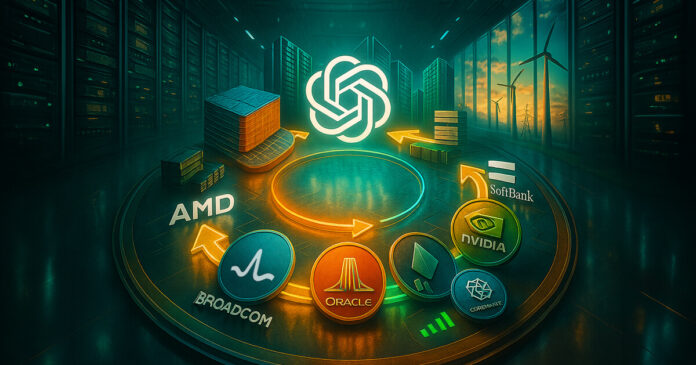OpenAI has embarked on an ambitious $300 billion hardware expansion, creating a complex feedback loop that ties its chip suppliers, financiers, and energy providers into a single, interconnected system. This massive undertaking has significant implications for the tech industry, with potential repercussions on Wall Street finance and the broader economy.
The company has secured multi-year agreements with AMD and Broadcom to deliver tens of millions of AI accelerators between 2026 and 2029, representing approximately 16 gigawatts of new computing power. This is equivalent to the entire electricity consumption of some small nations, highlighting the enormous scale of OpenAI’s expansion plans. AMD will provide 6 gigawatts of Instinct GPUs, with stock warrants tied to performance milestones, while Broadcom will co-develop and deliver 10 gigawatts of custom silicon and rack systems over the same period.
Circular Economy of Artificial Intelligence
The structure of these agreements suggests a circular economy pattern in AI infrastructure, where capital, equity incentives, and purchasing commitments interlock between vendors, infrastructure providers, and model operators. This creates a feedback loop between a supplier’s valuation and a customer’s capacity expansion path, as seen in the AMD agreement. Similarly, Nvidia’s 7% stake in CoreWeave and the subsequent expansion of their agreements with OpenAI by $6.5 billion demonstrate the tight link between supplier participation, infrastructure capacity, and OpenAI’s demand path.
Bloomberg has reported on supplier financing loops involving up to $100 billion in Nvidia commitments tied to OpenAI’s chip purchases, which can influence the optics of demand and partially fund the supplier itself. This complex web of relationships and financing arrangements has the potential to rewiring Wall Street finance and creating new opportunities for growth and investment.
AI Energy Requirements and Execution Risks
The enormous energy requirements of AI systems pose significant challenges, with Goldman Sachs predicting a 165% increase in global data center electricity demand by 2030 compared to 2023. This trend will force data center operators into long-term power purchase agreements, on-site generation, and relocation as new clusters come online between 2026 and 2029. The regulatory path remains fluid, with the UK Competition and Markets Authority concluding that Microsoft’s partnership with OpenAI was not eligible for a merger investigation, although this situation could be revised if new capital-linked supply arrangements increase concerns about market power.
Custom silicon is a critical cost lever, with Broadcom’s program aiming to deliver significant performance gains per watt. If successful, this could shift the unit economics of the circular model toward self-financing cash flows as utilization increases. However, execution risks exist in toolchains, packaging, and storage bandwidth, with the schedule beginning in the second half of 2026 and a multi-year increase through 2029.
Tracking Progress and Measuring Success
To track the transition from a circular economy to sustainability, it is essential to combine data center utilization metrics with energy contract coverage rates and the revenue mix from corporate usage contracts. As deployment begins in the second half of 2026, the funding loops embedded in these deals will act as a bridge capital for a more stable computing economy rather than a source of correlation risk between vendors, infrastructure providers, and the lab.
The forward path focuses on a 24- to 36-month window during which the first waves of Broadcom systems and AMD come online, power contracts are established at Stargate sites, and revenue-supported consumption increases through enterprise channels. OpenAI says the Broadcom rollout will be completed by the end of 2029, marking a significant milestone in the company’s ambitious expansion plans.
| Capacity | Partner | First Missions | Goal Completion | Notes |
|---|---|---|---|---|
| 6 GW | AMD | 2H26 | N/A | Milestone-based warrants for up to 160 million AMD shares, OpenAI beneficiary |
| 10 GW | Broadcom | 2H26 | End of 2029 | Custom accelerators and racks co-developed with OpenAI |
| 4.5-5.5 GW | Oracle, SoftBank | Phased | N/A | Five new Stargate locations in the USA, partnership volume over 300 billion US dollars over a period of five years |
For more information on OpenAI’s $300 billion hardware expansion and its implications for the tech industry, visit https://cryptoslate.com/openai-builds-300b-bubble-machine-the-feedback-loop-rewiring-wall-street-finance/

